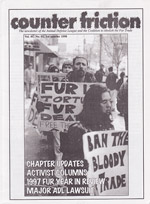The Archives
-
Periodicals
Animal Info
10.18.12 | PermalinkAnimal Info #1-8 (1995-1996. Christchurch, New Zealand)
Animal Info was a thin, photocopied newsletter that was published with the hopes of increasing the militancy of New Zealand’s animal activists. It’s pages contained news relevant to local campaigns, alongside the home addresses and phone numbers of various animal abusers. The zine’s rhetoric was, at times, over the top and even once racially insensitive. Issue #1 contains an N-bomb on the front page that was seemingly intended to make an anti-racist / speciesist point, but instead has the exact opposite effect.
Still, Animal Info is an inspiring example of committed activists organizing on a grassroots level and agitating for greater commitment in the struggle against speciesism. It’s international news coverage was impressive given the magazines small number of pages, and nicely bridges the U.S. coverage lapse between the time Open the Cages stopped publication and No Compromise began. All of us at CG would love to see this type of paper return to regional organizing in the United States and abroad.
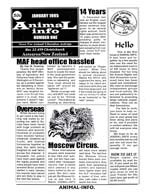
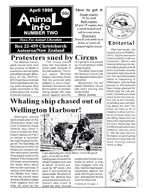
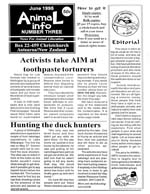


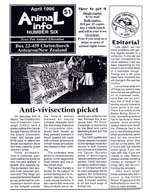
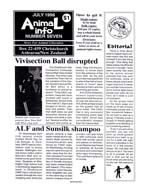
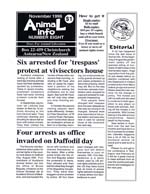
-
No Compromise, Periodicals
No Compromise #12-14
05.15.12 | PermalinkNo Compromise #12-14 (1999, Old Bridge, NJ and Santa Cruz, CA)
If I had to create a list of my favorite years in animal and earth liberation history, 1999 would be in the top 5. As the movement looked towards the new millennium there seemed to be an intense urgency in the air, perhaps people felt the need to close the 20th century with a bang or leave their mark before the world ended in a technological melt down on Y2K! Whatever the reasons, direct action reached a fever pitch. Lab raids returned to the United States, the Earth Liberation Front continued it’s ascendancy, Hillgrove farm was shut forever, and everyone seemed to be preparing for the World Trade Organization ministerial in Seattle. Across the globe there was a sense that people were not going to take it anymore, and whether you were struggling against bio-technology or prisons or speciesism, chances are good that you were employing some form of illegal tactic.
No Compromise may not have covered everything going on in the global struggle, but if it was animal lib related then chances are it was covered in these three issues. From the death of Alex Slack to end of the annual Hegins pigeon massacre, you’d be hard pressed to find a more complete overview of these twelve action packed months.
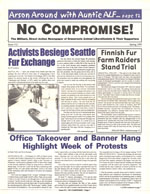
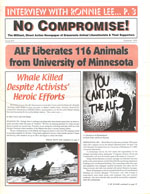
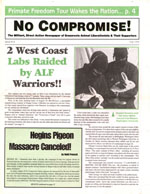
-
No Compromise, Periodicals
No Compromise #9, 10, 11
11.15.11 | PermalinkNo Compromise #9, 10, 11 (1998, Caldwell, NJ.)
After the shakeup caused by Freeman Wicklund’s departure, one might have expected No Compromise to slow it’s publishing schedule while it re-grouped. Instead, they had one of their most productive years, reporting on everything from the first daylight raid in the US, to the murder of Earth First! activist David “Gypsy” Chain. The volume of important articles in these issues is too great to summarize in a tiny blog post, so instead we would just like to encourage you to read each edition thoroughly. Truly, this is one of our favorite posts on Conflict Gypsy so far as it highlights so many significant events in the movement at the end of the 1990s.
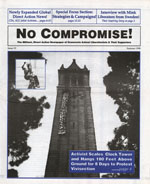
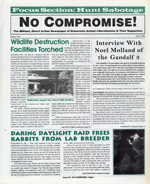

…
-
No Compromise, Periodicals
No Compromise #6-7
08.23.11 | PermalinkNo Compromise #6-7 (1997. Minneapolis, MN.)
The second year of No Compromise was packed with inspiring coverage of the growth of the militant grassroots, including some of the most important events of the 90s: Tony Wong’s hunger strike, the mass arrests and police riot at the Yerkes primate center, and the World Week for Animals in Laboratories arrests at the UC Davis primate center.
Tony Wong was only 16 years old when he was convicted for a civil disobedience action at the Lazurus department store. He immediately began a hungerstrike in prison, and after a month of not eating the staff at the juvenile facility where he was being held began force feeding him animal products through a tube forcefully inserted through his nose. The brutality faced by Tony acted as a lightning rod, and soon large demonstrations and acts of sabotage rippled across the country. The most important thing that Tony did though was to set an example of dedication that others could admire and aspire to in their own lives. Sadly, Tony eventually embraced a deeply speciesist political transformation and began consuming animals again after sacrificing so much to save them.
World Week in 1997 saw miniature police riots in Georgia and California. The protests themselves were not as important as the resulting boost to the movement created by the heavy handedness of the cops. As van loads of activists traveled to these demonstrations and found themselves sharing jail cells with like minded comrades, they soon formed tighter networks which led to greater revolutionary potential. The west coast and east coast both saw an upswing in regional actions after these arrests.
No Compromise was plagued by it’s usual production and distribution delays this year. It only got two issues finished, and they didn’t make it into people’s hands on the advertised cover dates, but both of these issues are wonderful documents of their era.
No Compromise #1-5 can be found here.
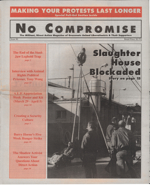
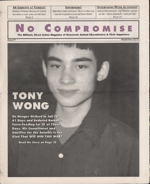
…
-
Periodicals
Out of the Cages #6-9
05.19.11 | PermalinkOut of the Cages #6 – 9 (1993-1994. Santa Cruz, CA. USA)
Out of the Cages is a wonderful magazine that filled an important niche in the pre-internet, pre-No Compromise 90s. As the main west coast publication of its time, it had a link to the 80s glory days that ran deep in the area it was printed. Santa Cruz had been the home of early US hunt saboteurs and the earliest cooperation between animal rights activists and Earth First! took place there. Rod Coronado, Jonathan Paul, and other early AR radicals called it home. This proximity to history gave the magazine a much different tone than Holocaust, or Dressed in Black, and unlike Militant Vegan, the group publishing OOTC were above ground liberationists, accessible for correspondence and submissions. This meant that the zine was always filled with fresh perspectives, letters, and debate, and that eventually groups from across the country got in touch to share ideas and announce their campaigns.
Conflict Gypsy would very much like a complete set of Out of the Cages. If you have any please contact us at conflictgypsy {{at}} gmail ((dot)) com


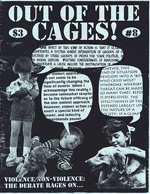

…
-
Periodicals
The Militant Vegan
03.14.11 | PermalinkThe Militant Vegan 1-8 (January 1993 – March 1995. USA.)
Militant Vegan was an anonymously produced zine that ran for 8 issues between 1993 and 1995. The final issue was never printed by the team who produced the magazine, instead the files were distributed online. Due to the poor quality of modems and low usage of the internet at the time the issue was mostly lost to history. Other things contributed to the mag’s obscurity as well. For example- there was no address to order the magazine from. Instead, originals were distributed to some animal rights groups and it was requested that they make copies, and that the readers of those copies make further copies to distribute to activists. Since the publication already relied on much cutting and pasting this method of circulation resulted in heavy generation loss of images, and obtaining readable copies wasn’t always easy. Even activists who were heavily involved in the movement at that time never saw every issue. Conflict Gypsy was luckily able to track down a complete set, including the rare eighth and final dispatch.
Printed in starkly contrasted black and white, and dressed in over-the-top, macho imagery, Militant Vegan’s primary purpose was to publicize actions and news ignored by mainstream movement publications. Otherwise, the philosophy of the magazine was vague. It was pleasant to read a brief denunciation of the sexism and homophobia advocated by the “Hardline movement” in MV’s early issues, but elsewhere there was less clarity. For example, ALF guidelines prohibiting violence appeared alongside statements celebrating the poisoning of animal products left on store shelves. (These actions turned out to be hoaxes, and no one was actually poisoned.) Frequent reminders that the publishers didn’t wish to encourage illegal activity appeared alongside instructions on how to do exactly that. And despite the angry condemnation of speciesism, cops are still referred to as pigs in a page reprinted from Defiance #1. The rhetoric could be ugly and was generally unlikely to convince people that direct action was an ethical tactic that provided the movement a way forward.
Despite all of this there was nothing quite like Militant Vegan at the time that it was published, and it documented the rise of a new era of grassroots activism in the United States prior to the publication of No Compromise. For the lucky few who could obtain copies, MV brought news of groups like Student Environmental Action League, Coalition to Abolish the Fur Trade, and Animal Defense League into their homes when glossy magazines like Animal’s Agenda did not. After a sharp dip in the number of underground actions in the earlier part of the 90s, Militant Vegan was a good source of information on the new trend towards smaller scale economic sabotage. Occasionally a well written original article appeared, and seeing press clippings from former radical (and current HSUS honcho) JP Goodwin’s convictions for sabotage remains amusing. Finally, the letters from prisoners were at times inspiring, and the coverage of Rod Coronado’s case from arrest to conviction is essential reading.
In total, Militant Vegan was a product of its time, written by amateurs who saw a niche and decided to fill it. It remains one of the only insider perspectives from that period of underground and radical grassroots animal liberation activism.








…
-
One-off publications
Counter Friction
03.14.11 | PermalinkCounter Friction #1 (1998, Bloomington, IN. USA)
By the late 90s, it was becoming apparent that despite the commitment and energy of the militant grassroots, little was being accomplished for non-humans. A lack of focus on a single target, and minimal regional or national coordination had left the movement with few gains, frustrated organizers, and many participants drifting away. One early attempt at correcting the problem was a drive by members of the Animal Defense Leagues and CAFT to unify their efforts by publishing a joint newsletter called Counter Friction.
Counter Friction was well intentioned, but upon its release it had little impact. First and foremost, if anything the magazine served to highlight the overly diverse targets and lack of framework within the groups. Some groups were focused on fur, some on fundraising, some on vegan outreach, and despite JP Goodwin’s call for unified action, everywhere else in the magazine there was a sense of not knowing what to do next. Second, the publication came out during a time period of intense turmoil and lower participation caused by the conflict between supporters of Freeman Wicklund’s ill fated strategic non-violence plan, and more traditional grassroots militants who supported underground activity. Third, the articles were written by organizers who might be proficient at putting together a protest but miserable at composing a few paragraphs about it. With few exceptions the content was poorly written. Finally, there was an unintentional conflict in the mission for the newsletter: On the one hand it was meant to start creating a centralized clearinghouse for CAFT and ADL, but the other purpose was to drive people towards local chapters. Subscribers were told to contact local groups for subscriptions, to send submissions to the central group, to contact CAFT for merchandise, to contact ADL for literature, and in the end confusion abounded.
By the time managing editor Rachael Astachan requested that chapters send in articles and updates for the second issue the steam had run out for many of the ADL’s and CAFT affiliates. In a frustrated e-mail to the ADL group e-mail list she left the project, and it was never revived.
…
-
Periodicals
Memphis Vegan #5
03.14.11 | PermalinkMilitant Couple seeking Memphis Vegan
US: We are two friends who run a website archiving animal rights and environmental publications. Him: A rabid hoarder of rarities. Her: Amused by the meshing of conservative politics and veganism. You: A little odd but a fun third to our party. Come to us and find out all the magic we have to offer. Feel free to bring along your boy X Shawn Youngblood X. Smooooch.
(In other words, we’d really like to track down more issues of this publication. Please contact us at conflictgypsy ((at)) gmail ((dot)) com if you can help us obtain this treasure!)
…
-
Periodicals
Do Not Consider Yourself Free
03.14.11 | PermalinkDo Not Consider Yourself Free # 1-3 (1997 – 1998. New York, NY. USA.)
Do Not Consider Yourself Free was the official newsletter of the New York City Animal Defense League chapter. Contributors included many prominent 90s activists, such as Sarahjane Blum, Patrick Kwan, Kim Berardi, Ryan Shapiro, Lance Morosini, Brian Smith, Melanie Bartlett, Darius Fulmer, Justin Taylor, Christine Matyasovsky, and Lauren Gazzola. The publication primarily covered the ADL’s spectacularly planned acts of civil disobedience against the fur trade and many arrests of its members, but also included interviews and original articles. It remains one of the most well known and fondly remembered newsletters of its era.
Conflict Gypsy is proud to present the complete set here along with this new introduction by Ryan Shapiro.
“The late 1990s was a different world, and the NYC Animal Defense League rocked that world. Working closely with the Long Island, New Jersey, Connecticut, and Syracuse chapters of the ADL, as well as with the NYU animal rights organization SEAL, the NYC-based Wetlands Animal Rights Action Team, and DC-based Compassion Over Killing, NYC ADL warred against animal exploitation and abuse in New York City.
NYC ADL sought to combine the aggressive militancy that characterized the grassroots animal rights movement of the late 1990s with a parallel focus on strategic and tactical planning. Our goal was to be both radical and smart. Efficacy was our watchword. As such, NYC ADL members could be found in camos while recruiting at Earth Crisis shows and in suits and dresses while occupying the President’s office at NYU (even if we still had Firestorm playing on the President’s stereo).
We placed particular emphasis on our civil disobedience actions. In the heady days before 9-11 and the Animal Enterprise Terrorism Act, NYC ADL organized seemingly ceaseless opportunities to challenge animal exploitation by locking ourselves to things. Through boldness of vision, obsessive attention to detail, and the courage of our membership, NYC ADL sought to perfect the art of the urban blockade. Whether it was learning the science of concrete solidification or busting out the algebra to determine the optimal participant distribution for a lockdown, NYC ADL devoted ourselves to coordinating spectacular acts of civil disobedience that served as models for other groups around the country. Among our proudest accomplishments was to repeatedly shut down the world’s largest store, Macy’s Herald Square, in protest of Macy’s continued sale of fur.
Due primarily to the departure from NYC of many of ADL’s leading coordinators, the group began to falter in 2000. Even in its demise, however, NYC ADL served as a feeder for some of the most significant grassroots animal rights campaigns of the new millennium. After leaving NY, veterans of NYC ADL served as key participants in, amongst others, the SHAC campaign, the campaign to shut down Makah whaling, and the campaign to expose factory farming through “open rescue.”
Over a decade later, NYC ADL seems both like yesterday and a lifetime ago. In either form of memory, however, I remain deeply humbled to have served alongside activists so passionate and dedicated. It is truly one of the great honors of my life to have been a part of NYC ADL. Thank you to everyone who fought for animals alongside us, and to everyone who continues the fight today. NYC ADL is gone, but the message lives on: As long as others are held captive, do not consider yourself free.”

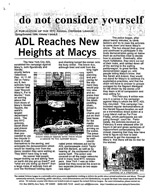

…
